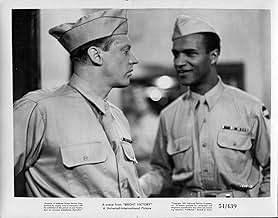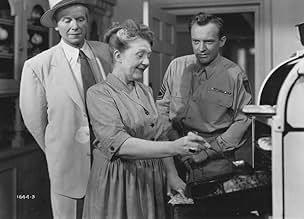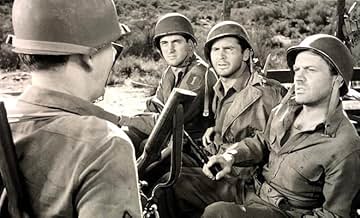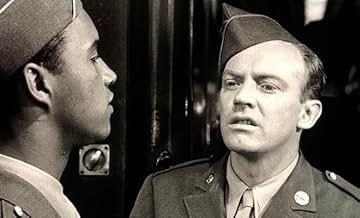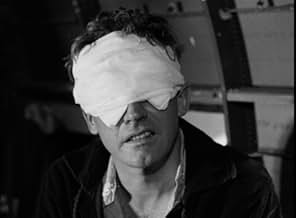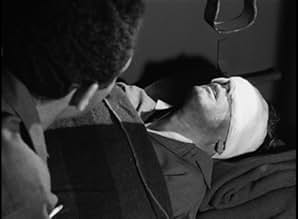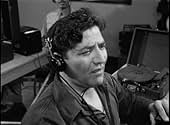IMDb रेटिंग
7.3/10
1.1 हज़ार
आपकी रेटिंग
अपनी भाषा में प्लॉट जोड़ेंAfter he gets blinded by a German sniper's bullet in 1943, Sergeant Larry Nevins begins the long and painful road to recovery.After he gets blinded by a German sniper's bullet in 1943, Sergeant Larry Nevins begins the long and painful road to recovery.After he gets blinded by a German sniper's bullet in 1943, Sergeant Larry Nevins begins the long and painful road to recovery.
- 2 ऑस्कर के लिए नामांकित
- 5 जीत और कुल 6 नामांकन
Julie Adams
- Chris Paterson
- (as Julia Adams)
फ़ीचर्ड समीक्षाएं
10g2608671
I first saw this movie as a kid in the early 60's at my dad's suggestion. He wanted me to pay attention to the real story, that being that racism has no place in a free society. I did pay attention, and to this day, his instance that I watch the movie for content is among the fondest memories I have of my Dad. He taught me how to hunt, fish, drive a car, paint a house and respect people. It is all the more remarkable, especially since I grew up in an all white town in western PA. Also, I now live no more than a few hundred yards where the movie was made. The former VF Army Hospital is now mostly under the ownership of the VF Christian College - a great resource and an asset to our community. When my family moved here some 20 years ago, we immediately discovered the "old army base" and I frequently took our kids there to walk, play on the falling down miniature golf course and just try to imagine what the facility was like when it was in use (swimming pool, gymnasium, small duck pin bowing alley, full size golf course and two fishing ponds)-- and what the presence of the base meant to Phoenixville then. I actually played handball on that court that Artuhr Kennedy is tested on for obstacle perception. The facility specialized in head and eye injuries and had a very substantial psychiatric ward as well. Anyhow, along with the anti-racism message umbered in the movie, I enjoy the scenes of the old hospital and reflect on what it looks like now. And of course,-- the scenes of old Phoenixville, although way before my time, bring a sense of nostalgia to me that is hard to describe not being a native of the area. None the less, it's there. As an aside, for anyone who is interested; Phoenixville is where they filmed The Blob with Steve McQueen -- the Colonial theater still stands to this day and has become a landmark. Oddly enough, McQueen and Kennedy would appear together in Nevada Smith years later. It is indeed a small world.
What is really interesting about this movie, is the "race" issues it addresses and for the time in which it was made, that is rather remarkable.
The Nevins character is a good old boy from the South and openly expresses his racism. The first time is when he's on the plane headed back to the states and a black soldier sits next to to him. They're both from Florida start talking. Nevins asks him if he knows the country club and the guys says he served tables at it. Nevins now realizes the guy is black and immediately calls over a nurse to sit by him.
The next time is in the rehabilitation hospital. Nevins accidentally walks into a black soldier, also blind. All Nevins recognizes is the man's southern accent and offers to buy him a drink. They become "friends" and hang out together. Then one day, the other blind soldiers mention there are some new patients coming into their ward and Nevins pops off, "Yeah, and I heard 3 of them are (uses the "N" word)". The black guys just stops in his tracks now realizing how his new friend really thinks and feels.
The other blind white soldiers already knew the guy was black and remarked "Maybe he thought you were colored too".
Later on Nevins goes home and is with his parents, who are equally racist. Nevins starts to "see" the errors of his ways/thinking. There is a bit of justification from the father that that was how they were brought up, etc., but for 1951 it is amazing they were even addressing such things let alone using the "N" word.
The Nevins character is a good old boy from the South and openly expresses his racism. The first time is when he's on the plane headed back to the states and a black soldier sits next to to him. They're both from Florida start talking. Nevins asks him if he knows the country club and the guys says he served tables at it. Nevins now realizes the guy is black and immediately calls over a nurse to sit by him.
The next time is in the rehabilitation hospital. Nevins accidentally walks into a black soldier, also blind. All Nevins recognizes is the man's southern accent and offers to buy him a drink. They become "friends" and hang out together. Then one day, the other blind soldiers mention there are some new patients coming into their ward and Nevins pops off, "Yeah, and I heard 3 of them are (uses the "N" word)". The black guys just stops in his tracks now realizing how his new friend really thinks and feels.
The other blind white soldiers already knew the guy was black and remarked "Maybe he thought you were colored too".
Later on Nevins goes home and is with his parents, who are equally racist. Nevins starts to "see" the errors of his ways/thinking. There is a bit of justification from the father that that was how they were brought up, etc., but for 1951 it is amazing they were even addressing such things let alone using the "N" word.
This film was partially filmed on location at Valley Forge General Hospital (and NOT at the actual Valley Forge), in Phoenixville, PA. This hospital was a center for rehabilitating blind soldiers during World War II. Every enlisted man assigned to Valley Forge Gen. Hosp. after 1952 was shown this film as part of their orientation to the hospital.
Some of the interior and exterior shots were done at the hospital. The scenes where the soldier walks toward blank walls was done at the outdoor handball courts at the hospital. Several ward scenes were also shot there.
It was nice to see medics portrayed as something other than just battlefield personnel.
I would love to have a video of this film, but such is not available.
Well acted, and reasonably realistic.
Some of the interior and exterior shots were done at the hospital. The scenes where the soldier walks toward blank walls was done at the outdoor handball courts at the hospital. Several ward scenes were also shot there.
It was nice to see medics portrayed as something other than just battlefield personnel.
I would love to have a video of this film, but such is not available.
Well acted, and reasonably realistic.
In "Dark Victory" the lead goes blind and faces encroaching death. In "Bright Victory" the lead's already blind and faces encroaching life.
The latter seems far more challenging.
Arthur Kennedy's Oscar-nominated performance as Larry buoys this film from start to finish. His excellent naturalistic style is perfect for the returning disabled vet.
Peggy Dow (as Judy) and Julie Adams (as Chris) are both fine as the women in Larry's life. The script is so sensitively written that both female characters are totally believable in their motivations.
James Edwards delivers his usual solid work as Joe, Larry's best friend.
Mark Robson's direction is efficient and level headed, and the photography, editing and music are all extremely tasteful.
This is one of Authur Kennedy's finest hours, amongst a distinguished body of work during a most versatile career.
The latter seems far more challenging.
Arthur Kennedy's Oscar-nominated performance as Larry buoys this film from start to finish. His excellent naturalistic style is perfect for the returning disabled vet.
Peggy Dow (as Judy) and Julie Adams (as Chris) are both fine as the women in Larry's life. The script is so sensitively written that both female characters are totally believable in their motivations.
James Edwards delivers his usual solid work as Joe, Larry's best friend.
Mark Robson's direction is efficient and level headed, and the photography, editing and music are all extremely tasteful.
This is one of Authur Kennedy's finest hours, amongst a distinguished body of work during a most versatile career.
Reminds me more of Pride of the Marines than Best Years of Their Lives. Blinded returning vet has to readjust. Arthur Kennedy never was better than in this movie. The ending in this cynical age seems too upbeat, but such endings DID happen. See: The Men with Brando for another crippled returning vet film.
क्या आपको पता है
- ट्रिवियाTen blind WWII veterans at the hospital appeared as extras and were advisers for this film.
- गूफ़The locomotive pulling the train when Joe arrives home in Florida was not produced by American Locomotive Company until 1950, seven years after the actual event. Diesel locomotives were not used on local trains until after the war years.
- भाव
Larry Nevins: I told ya i wanted security, remember... well I was looking for it in all the wrong places. Nobody can ever give it to you Judy. That way, it costs too much, you gotta make it for yourself.
टॉप पसंद
रेटिंग देने के लिए साइन-इन करें और वैयक्तिकृत सुझावों के लिए वॉचलिस्ट करें
- How long is Bright Victory?Alexa द्वारा संचालित
विवरण
- रिलीज़ की तारीख़
- कंट्री ऑफ़ ओरिजिन
- भाषा
- इस रूप में भी जाना जाता है
- Lights Out
- फ़िल्माने की जगहें
- उत्पादन कंपनी
- IMDbPro पर और कंपनी क्रेडिट देखें
- चलने की अवधि
- 1 घं 37 मि(97 min)
- रंग
- पक्ष अनुपात
- 1.37 : 1
इस पेज में योगदान दें
किसी बदलाव का सुझाव दें या अनुपलब्ध कॉन्टेंट जोड़ें

